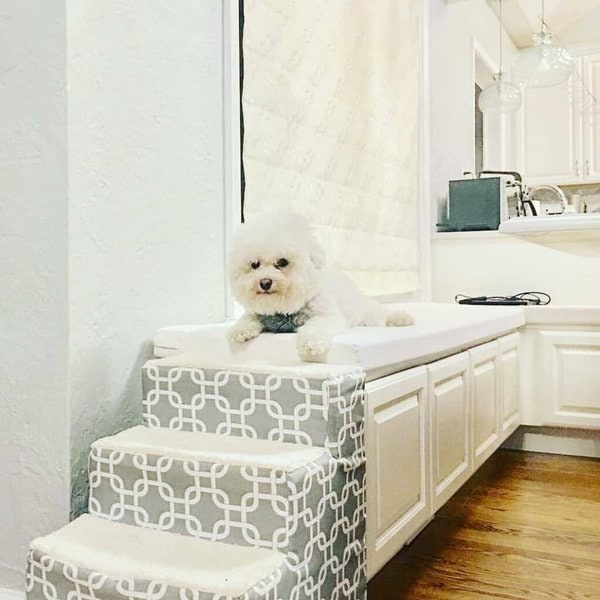The best dog stairs steps is CertiPUR US Certified Foam Dog Steps.
What are dog stairs, and how do they benefit your four-legged friends? Dogs can be just as clumsy as humans when it comes to climbing up or down a flight of stairs. This is especially true for older dogs that have arthritis in their hips, legs, or back. Dog stairs and steps help make the process easier on your pup while also preventing injuries from falls.
Besides, young puppies have developing bodies. Until their paws and joints are fully grown, they can be vulnerable to injuries all the time, and dog stairs could help reduce this risk.
The best dog stairs & steps are sturdy and easy to assemble, which is why we have compiled this list of our favorite dog stair products on the market today. Read on for more!
#1 Best Pet Supplies CertiPUR-US Foam Dog Steps
The foam pet steps from Best Pet Supplies come with a soft and fuzzy surface. They are safe and quite comfortable for both smaller and larger breed dogs. In addition to this, the dog steps are created using CertiPUR-US certified foam. The foam has a reputation for being sustainable and 100% natural. They don’t have any toxins that could potentially harm your pup.
It also has a soft fabric cover on the top. The fabric covers are available in 12 different colors and patterns. The dog steps are very stylish and will easily go with the rest of the décor in your home. They also deliver great traction for dogs that want to climb. Even dogs that have never used stairs before will definitely enjoy this one. The fabric cover can be removed and is machine washable too.
The CertiPUR-US certified foam dog steps are quite sturdy. This makes them perfect for dogs of all sizes. Despite the sturdy nature, the dog steps are soft at the top of the foam. As a result, dogs with weak paws and joints can still use them. We also loved the stylish covers. The fabrics come in 12 different colors and patterns that can easily work with any décor at home.
Pros
- This Best Pet dog steps product features an anti-slip bottom design that provides stability and prevents the stair from dangerously moving around when it is being climbed by a pooch.
- The cover of this Best Pet doggie stair is made of fabric that can be completely removed and machine-washed to make maintenance convenient for customers.
- Foam used to manufacture the Best Pet dog step product is sourced in the United States and CertiPUR-US certified as being free of ozone depleters, PDBW flame retardants, mercury, lead, and other substances that are found to be toxic to pooches.
- Best Pet Supplies’ dog steps product is available in three height options – 3-step (H: 13.5”), 4-step (H: 18”), and 5-step (H: 22.5”) to ensure compatibility with various heights and assist customers to purchase a product that can comfortably carry out the required function.
- The linen that covers this canine stairs product comes in five different color options to enable customers to make a choice that will blend with existing home décor.
Cons
- Despite the inclusion of an anti-slip bottom, several customers have reported that this canine stair product tends to move around and tip over easily when being climbed by a pooch.
- The softness of the foam used to manufacture this Best Pet product often results in a pooch’s feet sinking into the stairs, thereby resulting in the dog’s instability.
We choose this product as our top pick because of its CertiPUR-US certified foam for added safety and free of toxic heavy metals, such as lead and mercury, and also its anti-slip bottom that holds the product in place while in use.
#2 Pick Pet Gear Easy Step II Dog Stairs
The Pet Gear Easy Step II Pet Stairs is perfect for dog owners who are looking for value at a relatively low price. The product offers wide and deep stair landings which are perfect for smaller breeds like pugs and terriers. Each step on the stairs has an outstanding grip too. The dogs can jump and climb without the risk of sliding.
In addition to this, every step of the dog stairs is covered with a removable and machine washable tread. These new dog steps are easy to assemble too. It takes a few minutes and you won’t need any tools for the job. The dog steps can also be snapped together and taken apart for easy storage.
The Pet Gear Easy Step II Stairs are designed for small dogs. They will also deliver excellent grip.Your dogs can climb and play around without sliding. The treads on each step add to the stylish nature of this product. They can also be removed and cleaned anytime. This makes the overall maintenance quite easy.
Pros
- Pick Pet’s dog stair is easy to set up and install, and assembly can be carried out in a matter of minutes without needing to use tools or special equipment.
- The inclusion of rubber grippers on the base of the Easy Step II help provide a degree of stability and prevent the stair from moving around when it is being climbed by a pooch.
- The carpet tread used to cover this canine stairs product can be removed easily and conveniently machine washed by customers, thereby making overall maintenance stress-free.
- The Pick Pet Easy Step II features an innovative inclined design that slopes gently upwards to offer more height and reduce the number of steps that a pooch needs to climb before reaching its destination.
- The wide and deep stairs featured on this product makes it possible for small-sized dogs to comfortably place their body on each platform and climb upwards.
Cons
- The poor stability at the top end of this canine step often results in the stairs dangerously tipping backward when a pooch steps on the edge closer to the bed or couch.
- Several customers have claimed that the Pick Pet stairs have steps that are too small for their large-sized pooches to climb safely.
#3 Pet Loader Light 16” Platform
As the name suggests, the Pet Loader Light 16” Platform can be perfect for moving dogs around. So, if you are having trouble loading your dog into the car, these dog steps will take away all the hassle. There are different models available. Each has a different number of steps that range between three and five.
The product is foldable too for easy storage and transport. It is also average in size. However, it can be used by smaller and bigger-sized dogs. Besides, the multiple steps on the loader make it perfect even for the most skittish dogs. It is the perfect way of loading your dog into the car without any risk of injury.
The versatility of the Pet Loader Light 16” Platform is definitely something worth noting. You can choose a 3-step, a 4-step, or a 5-step loader depending on the size of your dog. We also liked the fact that it’s a hassle-free product. It’s very easy to use. You just extend the steps, allow your pup to jump into the car, fold it back, and store it for future use. This is the kind of convenience that every dog owner would love!
Pros
- The Pet Loader 16” platform comes with a patented latch system that is designed to keep the stairs stable under the weight of a pooch climbing upwards or downwards.
- This Pet Loader product features a stair depth of, at least, 11” to accommodate the space between a pooch’s legs, and the gently inclined design of each stair is designed to put less stress on a dog’s joints.
- This canine stairs product is designed to be easily folded down into a compact size for customers to conveniently pick up and move around for easy transportation and storage when not in use.
- The solid and carpeted stair design of this Pet Loader product is intended to provide pooches with a solid footing when climbing up the platform.
- The versatility of the Pet Loader platform makes it suitable for use either at home for climbing on beds and couches, climbing tall tables at the vet’s or groomer’s place, or assisting a pooch in climbing into vehicles.
Cons
- The Pet Loader 16” platform stair product for dogs isn’t compatible for use with side-entry vehicles.
- The 5-step version of the Pet Loader platform is considerably heavy and may be difficult for some customers to move.
#4 Arf Pets Wood Dog Stairs
Product
The Arf Pets Wood Dog Stairs is just convenient and stylish. It comes with a rich espresso finish that will accentuate the decor in your living room. The sturdy and strong construction ensures dogs of all sizes can jump and climb anytime. The stairs are also foldable. You can move or put it away in storage conveniently in case you run out of space.
The dog steps will also come with safety side rails which add to the safety of the product. The Arf Pets Wood Dog Stairs don’t need to be assembled either. Just find a nice little corner in the room and place them.
The Arf Pets Wood Dog Stairs is probably one of the most stylish products in this list. It’s just easy on the eye. We also loved the sturdy construction. The dog steps are adjustable and deliver enough flexibility for all types of dogs.
Pros
- Customers can adjust the height of the Arf Pets wood dog stairs between 21.5” to 25.5”, depending on the level of elevation of the surface to be climbed by a pooch.
- The foldable design of this canine stairs product makes it possible for customers to collapse the structure into small, compact sizes for convenient storage and transportation.
- The fabric-lined stairs of this Arf Pets product are soft and gentle, offering protection for a pooch’s paws while providing traction to ensure that a dog can climb up the steps without slipping and falling.
- This canine stair product features a stylish finish that can seamlessly blend with, and even improve existing home décor and aesthetics.
- The Arf Pets dog stairs package comes with a bonus pack of pads to protect wood floors from damage due to scratches from the base of the stair.
Cons
- Several customers have commented that the steps of the Arf Pets wood stairs are too steep for their pooches to climb.
- The scratch prevention tape that comes included with this canine steps product tends to wear off and become ineffective fairly quickly.
#5 Pet Gear Easy Step IV Dog Stairs
The Pet Gear Easy Step IV Pet Stairs are luxuriously designed to comfortably allow dogs to climb on cars, couches, and beds. The stairs feature deep angled landings on each step that allow small dogs or cats to get their four paws on every step.
This makes climbing much easier and safer too. The stairs also have rubber grips on the bottom. The grips are designed to keep stairs glued in one place. No matter how hard your pooch jumps or climbs, the stairs will not move.
The stairs can easily be assembled in a few minutes without any tools. They also feature a soft cover on each step for extra grip and style. The covers are removable and they can be machine washed for easy maintenance.
The stairs are not relatively high and only measure 19.84 inches in height. Each step measures about 5 to 6 inches, so they can be perfect for both smaller and big dogs. According to the manufacturer, this pair of stairs can support a maximum weight of 50 lbs.
The Pet Gear Easy Step IV Pet Stairs are relatively safer compared to many designs in the market. The deep angled landings on each step allow dogs to climb up and down safely. This reduces the risk of injury significantly. We also liked the non slip rubber grips at the bottom of the dog stairs. The grips hold itself in place for additional safety.
Pros
- The Easy Step IV features rubber grippers on the bottom that promote stability and prevent any startling movement of the stairs when it is being climbed by a pooch.
- The soft step cover of the Pet Gear Step IV can be easily removed and machine-washed for convenient maintenance and cleaning.
- The wide and deep step design of this Pet Gear product makes it possible for pooches to fit their entire frame on each platform and climb up or down without difficulties.
- Customers can snap together the components of the Step IV stairs for easy assembly and installation, without needing to use tools.
- Pet Gear’s Easy Step IV features an innovative inclined design that reduces the number of steps a pooch needs to climb before getting to its destination.
Cons
- The inclined design of this canine stair product makes the steps too steep for some senior dogs and pooches with mobility issues to comfortably climb.
- Multiple customers have commented that the covers they received with the Easy Care IV stairs package were too small to completely engulf the steps.
#6 Premier Pet Steps Tall Raised Panel Dog Steps
In case you are in the market for something a little classier and more elegant, then the Premier Pet Steps won’t disappoint. The dog steps are created using wood and carpet accents. They are about 16.5 inches tall and look totally different from some of the popular dog steps in the market at the moment.
The wood construction is very sturdy too. The entire stairs can support up to 300 lbs in weight. This is a clear indication of how strong it is. Even people can climb up and down if they want. The Premier Pet Steps are simply a combination of classy design and strength. It’s something you will love to have displayed in your living room too.
The stylish nature of the Premier Pet Steps is the biggest appeal. The wooden design is finished with a unique stain and carpeting for a stunning look. Strength and durability are also quite good. There aren’t many dog steps in the market that can support 300 lbs in weight. This is a huge plus for people with big dogs. The great thing is that the Premier Pet Steps can also be used by smaller pets including cats.
Pros
- Customers can conveniently wipe down the steps with a damp cloth, furniture polish, or a quality carpet cleaner to carry out cleaning and maintenance activities on this canine stairs product.
- The sturdy design of this canine stairs product can comfortably support the weight of large-sized pooches without collapsing.
- The Premier Pet dog wooden steps product features a deep rich finish, with the red oak’s natural wood grain details being clearly visible to provide an aesthetically pleasing appearance that enhances home décor.
- Premier Pet’s canine stairs product comes ready to use, with there being no need for customers to carry out any assembly or installation procedures.
- Each step of the Premier Pet canine stair is carpeted with soft fabric material that is gentle on a pooch’s paws and also provides a surface that dogs can comfortably grip and climb.
Cons
- The uncarpeted sides located on each edge of this product’s steps pose a design flaw that causes medium and large-sized pooches to slip dangerously.
- The depth of this canine stair product is too low for large dogs to comfortably and safely climb.
#7 Majestic Pet Portable Dog Stairs
These simple stairs are easily portable and can be used to help dogs into beds and other high places. The stairs are available in six fun and exciting colors that are embellished with additional patterns. This allows them to go well with the furnishing in any home.
The stairs offer a cushioned surface too that takes the weight off your canine’s feet as it lands. This leads to extra safety. These cushioned covers can be removed and washed too. The Majestic Pet Portable Pet Stairs are made in the US from upholstery grade fabrics. As long as they are properly maintained, they can last for a very long time.
The Majestic Pet Portable Pet Stairs are nice looking. The wide variety of colors and patterns ensures they are able to rhyme with furnishing in your living room. Safety too is quite good. The cushioned steps ensure the landing for dogs is as easy as possible. In case you are looking for a good pair of stairs for puppies, small dogs, or cats, we would highly recommend this one.
Pros
- The lightweight design of Majestic Pet’s portable dog stairs makes it easy for customers to carry and transport the stairs from one place to another.
- This canine stairs product features a cushioned surface that helps relieve the stress on the joints of pooches suffering from medical conditions such as arthritis, hip dysplasia, and obesity.
- This portable dog stairs product is available in a variety of color options to enable customers to pick furniture that will blend well with existing home décor.
- The sturdy foam insert that comes with the Majestic Pet portable stairs product helps to cushion the painful effects of accidentally running into the stairs.
- The removable cover of this canine pet stairs product can be removed and machine-washed on a gentle cycle and tumble-dried to provide customers with a convenient way for customers to clean spills, stains, and dirt.
Cons
- Several customers claim that the foam material used to produce this canine step product isn’t sturdy enough, thereby resulting in the stair tending to tilt and fall over under a pooch’s weight.
- The Majestic Pet stairs are occasionally too deep for small-sized pooches to comfortably climb up without assistance.
#8 PETMAKER Folding Plastic Dog Stairs
Give your dog an easy way up to anything with these simple and high-quality dog stairs. These dog steps from PETMAKER are perfect for any kind of dog but are recommended for puppies, kittens, and senior animals that have lost some agility. Each step has a carpeted tread too for extra traction.
The stairs can be folded for easy storage and transport. There is also a unique locking system. Once the stairs are assembled, the system keeps the dog steps in place all the time. This is an important safety feature that you won’t find in many other designs out there.
The safety of the PETMAKER Folding Plastic Pet Stairs is definitely one of its strong points. Each step in these stairs is carpeted for excellent traction. The side rails also ensure your pup can jump and climb without slipping. There is a locking mechanism that keeps the steps in place once they are assembled. We also loved the simple and foldable design that allows for easy storage and mobility.
Pros
- PETMAKER’s folding stairs design features edge rails that are intended to keep pooches from falling off the sides of the steps.
- This canine stair product from PETMAKER features a combination of non-slip foam pads and a snap-lock feature that are both intended to keep the stairs secure in place and protect pooches climbing up the steps.
- The adhesive-back felt step covers of the PETMAKER folding stairs provide pooches with enough traction and grip to comfortably climb up the steps without slipping or falling off.
- The collapsible design of this canine stairs product makes it possible for customers to fold the product into a compact size and store it without taking up much storage space.
- The durable plastic material of the PETMAKER folding plastic stairs can be conveniently cleaned with a damp cloth to get rid of stains, dirt, and spills.
Cons
- Several customers have commented that the PETMAKER stairs tend to collapse and fold up while pooches are climbing up the steps.
- A pooch’s leg can dangerously get caught between the gap that is located between the top stair of this product and the bed.
#9 PetSafe Solvit PupSTEP Plus Dog Stairs
The PetSafe Solvit PupSTEP Plus Pet Stairs offers a simple and easy way to grant your pooch access to high places. The versatility alone should be enough to convince you of its value. These dog steps are super light at just five lbs. They are very easy to move around the room but they are also very strong.
The dog steps can handle up to 120 lbs in weight. The PetSafe Solvit PupSTEP Stairs feature non-skid feet pads for extra safety. Although they are light and compact, these dog steps offer outstanding durability too.
The durability of the PetSafe Solvit PupSTEP is the biggest selling point. It can support up to 120 lbs in weight. The steps are very small and lightweight too. They can also be folded easily. These features make storage and mobility very convenient. The steps are very safe too. A built-in safety rail and non-skid surfaces are some of the safety highlights to look forward to.
Pros
- These dog stairs from PetSafe include safety features such as side rails and non-skid rubber feet to ensure that pooches don’t fall off when climbing up the steps.
- The carpeted treads of the Solvit PupSTEP stairs provide traction and grip to enhance a pooch’s confidence and make it possible for the pup to climb up the stairs without slipping.
- The lightweight build of the dog stairs makes it convenient for customers to lift and move the stairs from one place to another.
- The dog stairs are versatile and lightweight, thereby making them suitable for both indoor and outdoor use.
- Customers can fold the steps down flat to a compact size that can be conveniently stored while taking up minimal storage space.
Cons
- Multiple customers have commented that the PetSafe stairs wobble and shake under the weight of a pooch.
- The adhesive padding of the stairs tend to come off occasionally, thereby resulting in the stair getting displaced on smooth surfaces.
#10 Zinus PS-C2118C Easy Pet Stairs
The Zinus PS-C2118C easy pet stairs completes our top eleven picks. They are comfortable and versatile. This is because they are available in five different sizes and can accommodate dogs of all sizes and weights. The stairs also come with high-density foam.
The foam is relatively soft on your dog’s joints and paws. You don’t need to assemble once you buy. The stairs are cream in color and this neutral shade can blend into any décor easily.
The versatility is the most notable feature. The Zinus PS-C2118C easy pet stairs is available in five different sizes. This gives you the chance to pick stairs that are ideal for your dog. We also loved the neutral cream finish on the upholstery. It’s a very unique color that will easily blend in with your furnishing and décor.
Pros
- Zinus’ Easy Pet Stair features a high-density CertiPUR-US certified foam interior that provides a surface that is gentle on a pooch’s paws.
- The Zinus PS-C2118C is easy for customers to assemble, and the product also has a helpful installation guide for those finding it difficult to set up the stairs.
- The lightweight design of the Easy Pet stairs ensures that customers can move the product around the home and use it in places where their pooches may need help to climb.
- The machine-washable cover of the Zinus canine stair product can be easily removed by customers to conveniently carry out maintenance and cleaning activities.
- The PS-C2118C is available in five different size options – X-Small, Small, Medium, Large, and X-Large – to ensure that it can be safely used by pooches of different sizes.
Cons
- The steps of this canine stair product are reportedly too narrow for some dogs to comfortably and confidently climb.
- This canine stair product has a tendency to tip over when being climbed, thereby resulting in pooches getting scared and refusing to climb the steps.
#11 Topmart High-Density Foam Dog Steps
The Topmart High-Density Foam Dog Steps are perfect for pets with injuries or much older. The steps are 15.75 inches long by 7.1 inches wide each. They are built wide to help reduce the strain dogs may experience while climbing up or down. It can be used in a car, bed, or other places that your pet will need to access.
The dog steps from Topmart are made of a soft, machine washable cover and have a non-skid bottom surface. It has a corduroy cover which reduces the chances of your pet slipping when using it. It is stuffed with 30D high-density foam and is perfect for pets no more than 60 lbs in weight.
The Topmart High-Density Foam Dog Steps are great for your aging or injured furry friend. We love that it is stuffed with high-density foam and the outer cover is non-slip and machine washable. Make sure that you take time to open the vacuum compressed package for your pet’s safety.
Pros
- The corduroy cover of the Topmart canine steps provide enough friction and traction for a dog to climb up without slipping or miss-stepping.
- Topmart’s canine steps feature 30D high-density foam that rebounds after each step by a pooch, thereby ensuring that the product doesn’t easily lose shape.
- Customers can remove and machine-wash the cover of this canine dog stairs product to easily get rid of dirt and stains.
- The versatility of this canine stairs product makes it suitable for use with cars, beds, couches, and some other elevated surfaces that a pooch may need to climb.
- Topmart’s dog steps product comes with a complimentary pet hair removal tool that customers can use to remove dog hair from furniture.
Cons
- The Topmart steps are too narrow for large-sized dogs to climb without falling off the sides.
- Multiple customers have commented that the covers they received with this product were not wide enough to cover the steps.
Dog Steps & Stairs Buyer’s Guide
It’s not uncommon for dogs to have trouble getting into higher places. For example, dogs love to climb on the bed or on the couch to cuddle.
Dog steps and stairs make it easier for them to do this. You will not always be there to lift young dogs up to the bed or the couch. But the stairs will take care of this all the time even when you are not around. In other cases, you may have a dog that has lost its agility due to old age. Dog steps can help your canine companion climb up and down different places with ease.
Related: Best Dog Ramps
Dog Ramps VS Dog Stairs
Dog ramps can play the same role as the stairs but these are two different products. A lot of dog owners, however, prefer the stairs. They can easily fit into small spaces without any issues. However, some dogs, especially those that aren’t used to stairs, will need some time to get used to.
Related: Best Dog Lift Harness
Features To Consider When Looking For The Best Dog Steps
Dog steps and stairs come in different shapes and sizes. There are too many options out there. However, there are a number of important considerations you will need to make before you purchase one which we will cover here.
Safety
Dog stairs are designed to help dogs reach high places and as such, there will be a lot of climbing. As a dog owner, you must make sure the stairs are safe. Your pooch should be able to climb up and down without slipping or falling.
Mobility
It is also important to choose stairs that can conveniently be moved from one place to another. Dog steps are not designed for one location. Sometimes you may want to use them outside. For example, stairs are commonly used in lifting dogs into cars these days. Something that can be moved easily will be perfect for this.
Stability
A good pair of stairs must withstand the weight of your dog. In other words, the stairs should be stable enough to stick on the ground as the dog climbs up and down. This will be safer for both the dog and the owner. Various designs have unique weight specifications. Make sure you understand this before you buy.
Aesthetics
Dog stairs will probably go into your living room. In that case, it should be something that adds décor value to your spaces. Most designs in the market are very stylish but it all depends on your tastes and preferences.
Assembly
Once you buy the dog stairs from the store, you will probably need to set them up. Some stairs require assembly while others don’t. The great thing is that the majority of stairs can be put together with a lot of ease. You won’t even need any tools for this.

Dog Stairs VS Ramps: Which Do You Really Need?
If you’re reading this, you’re probably feeling undecided about which option to pick between dog steps/stairs or ramps. If you’ve never tried one of these options before it can be difficult to figure out which one would be a good fit for your home and your dog. That’s why we prepared a guide that’ll help you decide based on the advantages of each option while taking your needs and the needs of your dog into account.
What To Choose (Dog Stairs VS Dog Ramps)
Every dog owner has a unique set of requirements based on the design of their home and the needs of their canine companion. That means there’s no one-size-fits-all solution when it comes to canine products.
But, it’s understandable that most dog parents can’t tell the difference between dog stairs and steps. That’s because these two words have the same meaning, and are often used interchangeably, which is what we’ll be doing in this article.

Pros Of Dog Stairs Over Dog Ramps
There are many benefits of using dog stairs or steps instead of dog ramps, such as the following:
- Dog stairs are compact, and they don’t take up much space. Yet they’ll help your pooch reach the same height as a dog ramp. You can easily place the dog steps next to your bed or any tight space.
- Dog steps have an ergonomic design that makes it easier to store them when not in use.
- Stairs enable your dog to climb up and down the stairs safely regardless of their age or health condition. That’s why dog steps come highly recommended for elderly dogs or young pups that are still getting used to climbing stairs.
- Dog stairs are versatile enough for outdoor use, and you can easily store them next to your car, in your garage, or next to an outdoor deck.
- It’s easier to find customized dog stairs when compared to dog ramps. That’s because manufacturers are always interested in customizing dog stairs and catering to unique customer needs and specifications. All you have to do is provide the manufacturer with your specific dimension, and they’ll give you a quote of how much it’ll cost to customize the dog stairs.
- Dog stairs typically cost less than dog ramps because they’re cheaper to make. This makes them an ideal option for anyone that’s shopping on a budget.
Cons Of Dog Stairs Over Dog Ramps
There are also quite a few disadvantages worth mentioning when comparing dog stairs to dog ramps.
- Dog stairs aren’t as sturdy and reliable as dog ramps. Even if you lock your dog stairs tightly, they’ll never be as secure as a dog ramp.
- Generally, dog ramps are safer and more reliable for arthritic dogs because they don’t cause as much strain on your canine companion’s joints when climbing up and down the stairs. Dog steps or stairs can put a lot of strain on your pooch’s joints and make it difficult to navigate elevated surfaces.
- Most dogs favor ramps instead of steps because they have a wider, more reliable look. This is in stark contrast to dog stairs that look narrow and too small to walk on safely. That’s why dog ramps are often recommended for elderly dogs or injured dogs because your dog is less likely to feel apprehensive about climbing onto them.
With that said, different dogs have different expectations and preferences. Some dogs are so anxious about climbing onto elevated surfaces that they won’t go for stairs or ramps.
Related: Best Dog Wheelchairs
Final Thoughts
Dog stairs and steps are designed to help dogs climb into relatively high spaces with ease. Despite the huge variety of options in the market, our top pick comes highly recommended.
Each step on these stairs is reinforced with sustainable, non-toxic foam for excellent traction. The design is also stylish. The fabrics that cover the foam are available in many colors and patterns. Simply put, style, durability, and safety for dog owners are the features that our top pick on this list will shine.





